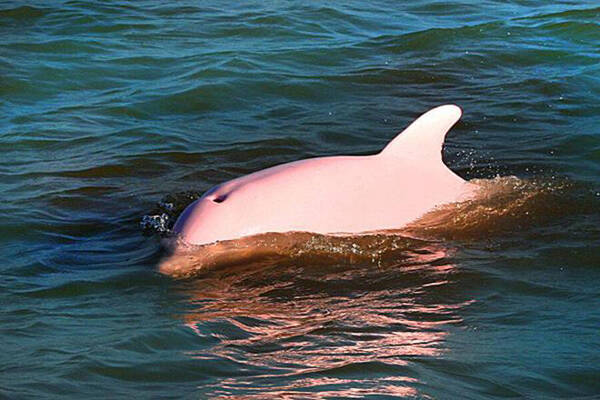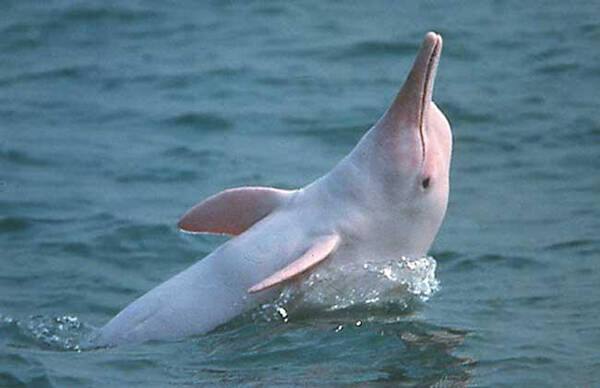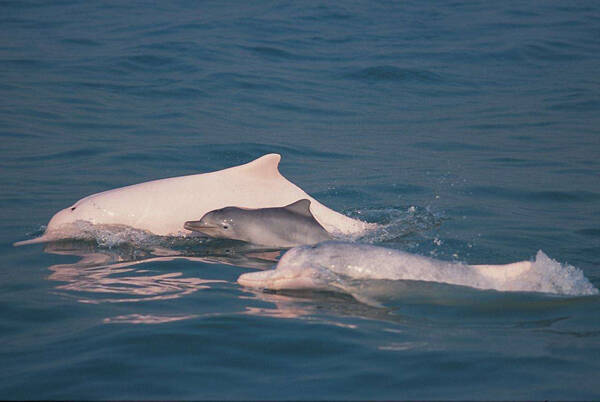Lipotes vexillifer
IUCN
LCBasic Information
Scientific classification
- name:Lipotes vexillifer
- Scientific Name:Lipotes vexillifer,Baiji, Yangtze River Dolphin,Baiji,zhú (ancient name), Baiji, Chinese finless porpoise, Baiji dolphin
- Outline:Cetacea
- Family:Odontoceti Baijidae Baiji
Vital signs
- length:253-229cm
- Weight:150-210kg
- lifetime:20-30years
Feature
In ancient Chinese literature, the Baiji dolphin is often used as a symbol of beauty and kindness.
Distribution and Habitat
The Baiji dolphin lives in the lower reaches of the Yangtze and Qiantang rivers in China, as well as in Poyang Lake and Dongting Lake. They like to stay near the large whirlpools formed next to sandbars. They mainly live in the Yangtze River and its tributaries, at the entrances of lakes and in the main stream of the Yangtze River near the sandbars in the middle of the river. The water depth is generally 10-20 meters, and the flow rate is about 1 meter per second. They are mostly active in sandbars and beach water sections with weeds and reeds. They are mostly found in river sections with sandbars. They often move around the confluence of forked streams at the head and tail of the island.
Appearance
The maximum body length of female Baiji dolphins is 253 cm, and that of male adults is 229 cm. There is obvious sexual dimorphism in body size. The Baiji dolphin has a medium and thick body, a narrow and slightly upturned beak, a round forehead, and a low triangular dorsal fin located about 2/3 of its body length from the snout to the back, which are its most striking identification features in the wild. The rostral process of the skull is long and narrow, narrowing slightly between the posterior end of the upper dentition and the preorbital concavity; there is an obvious lateral groove on the side of the rostral process, and a shallow groove about the same length as the upper dentition between the two maxillary bones on the ventral surface; the base of the maxilla It expands posteriorly and connects with the upper occipital bone at the posterior edge of the skull. The lateral edges are tilted upward to form the maxillary ridge, which is strongly upwardly curved at the orbit. The zygom
Details
The scientific name of the Baiji dolphin is Lipotes vexillifer, and its foreign name is Baiji. There is no subspecies. "Ji" is pronounced as "jì", and the media often writes it as "baiji dolphin". It is a small freshwater whale unique to China.

The Baiji dolphin diverged from the dolphin lineage (Delphinida), which includes all modern toothed whales except sperm whales. Fossil evidence shows that primitive dolphins were born 25 million years ago and entered the Yangtze River from the Pacific Ocean 20 million years ago. In September 1981, Chinese geologists discovered a fossil fragment of the mandible of a prehistoric animal in Guiping, Guangxi. This mandible came from an ancient Baiji dolphin, called "Proto-Baji" (genus name: Parapontoporia). The fossil records the ancient characteristics of the Proto-Baji more than 20 million years ago, and the modern Baiji is not much different from it. Perhaps because the habitat is relatively closed, there is less competition for survival and environmental changes, the Baiji retains the original form of its ancestors, so it is called a "living fossil".
China's understanding and description of the Baiji has a history of more than 2,000 years. The ancient name of Baiji dolphin is Ji (pronounced Ji), also known as Baiji. The earliest record is in the dictionary "Er Ya" of the Qin and Han dynasties, when it was called "Ji". It is said that the number at that time exceeded 5,000, and it was widely distributed in the Yangtze River Basin. The figure of Baiji dolphin can be found in the river with a total length of about 1,700 kilometers. Ancient humans once mistakenly classified Baiji dolphin as fish. In the Jin Dynasty, Guo Pu (276-324 AD), who annotated "Er Ya", made a detailed description of the morphology and habits of Ji in "Er Ya Annotations", and correctly classified Baiji dolphin as fish for the first time: "Ji, a member of the genus of the genus, has a body like a sturgeon and a tail like a fish. It has a small, sharp and long beak, and its teeth are arranged in a row, biting each other up and down. The nose is on the forehead and can make sounds. It has little meat and a lot of fat. It is born alive, eats small fish, and the big ones are more than ten feet long. There are many in the river." Kong Wuzhong of the Northern Song Dynasty wrote a poem called "Poem of Yangtze River Dolphin". The "white-maned" in the poem refers to the Baiji dolphin, and points out that it is not the same species as the Yangtze River dolphin: "The black one is the Yangtze River dolphin, and the white one is the white-maned one. They have different appearances and names, and live in the same big water. There are big fish in the deep water, and they are plundered to make themselves fat...."
There have been many records about the Baiji dolphin in ancient Chinese documents over the past two thousand years. The earliest discoverers of the Baiji dolphin were the working people in ancient China. The name of the Baiji dolphin has been passed down from generation to generation among the working people, and is still used by the majority of fishermen in modern times. According to surveys, except for the Qingji in Anhui and the Baijia or Jiangma in Jiangsu, fishermen in the middle and lower reaches of the Yangtze River (including Anhui and Jiangsu) all call it Baiji. The locals call it Baiji because its body color is relatively lighter than that of the Yangtze River dolphin, not because they mistakenly believe that it is all white.

In the early 1980s, the most common group was 2-6, sometimes forming a group of about 16. But it is also common to see individual baiji dolphins acting alone. The group-living baiji dolphins are usually led by an adult or elderly dolphin, with young dolphins in the middle and young and middle-aged dolphins behind. They are often seen swimming with finless porpoises, and the group behavior is particularly obvious during mating.
When breathing, the Baiji dolphin is low in the water, often only the top of the head, dorsal fin and a small part of the back are exposed. The breathing interval is mostly 10-30 seconds, and the longest dive can reach several minutes. In spring, they are sometimes seen jumping out of the water. In shallow waters, breathing is more frequent and the swimming speed is faster; in deep waters, the breathing interval is longer and the swimming speed is slower. The Baiji dolphin swims downstream at a speed of about 7.5-9.7 kilometers per hour, and upstream at a speed of about 2.7-4.9 kilometers per hour. The migration range can reach at least 200 kilometers. When encountering approaching ships, the Baiji dolphin usually dives to avoid them. Its tail fin is flat and divided into two forks, the pectoral fins on both sides are flat palm-shaped, and the dorsal fin is triangular. These four fins provide the Baiji with excellent control over direction and balance when swimming in the water. With its smooth and highly elastic skin and streamlined body, the Baiji can swim at a speed of 60 kilometers per hour when escaping danger. It usually swims at a speed of 10 to 15 kilometers per hour.
The Baiji breathes with its lungs, and it has to surface every 10-100 seconds to breathe, making a "hissing, hissing" sound, and sometimes spraying water. When breathing, the top of the head and the breathing hole first surface, followed by the back. It takes about 1-2 seconds to breathe out of the water, and about 20 seconds to dive each time. In special cases where it is frightened or aware of danger, it can dive for 200 seconds without coming out of the water to breathe. Under normal circumstances, the breathing rate is 109-150 times per hour. When the weather is hot and humid and a rainstorm is about to come, the baiji will frequently emerge from the water and rise and fall, so the baiji is also called the "baijiang pig". As a mammal, the baiji needs to continuously supply oxygen to the blood in its body just like humans. When land mammals are resting, they can breathe involuntarily under the control of the cerebellum, while all the breathing of cetaceans is autonomous breathing that requires the response of the brain, so breathing must be done in a conscious state. When they lose consciousness due to illness, injury, etc., they will sink to the bottom of the water. When the remaining oxygen in the blood is used up, they enter a state of brain death, so drowning in the water is the normal way for old and weak baiji to die.

The brain of the Baiji dolphin accounts for about 0.5% of its total body weight, which is close to the level of apes. Some scholars even believe that the IQ of the Baiji dolphin is higher than that of apes. The brain of mammals needs to enter a dormant state after being used for a period of time before it can function normally after awakening. Cetaceans have a unique brain system that allows half of the brain to rest and the other half to work. The brain of an adult Baiji is in a half-asleep and half-awake state for 7-8 hours a day (similar to the sleeping habits of adults), and the rest of the time the whole brain is awake.
The Baiji has a constant body temperature of about 36℃. It has high requirements for water temperature conditions, often staying in a fixed area for a period of time, and then moving to another area after the water temperature changes. It is accustomed to living in the deep water area in the center of the river, and also enters lakes and the confluence of tributaries and main streams. It is mainly active during the day and rests at night. It is timid and shy, and rarely approaches the shore and ships.
The Baiji eats mostly in the early morning and dusk, and often swims to shallow waters at dawn and dusk to prey on fish and shrimp. It finds food by its own ultrasonic signals and swallows it in a surprise attack. It has a strong digestive ability and swallows the food whole without chewing it. It has a large appetite, and its daily food intake can account for 10%-12% of its total body weight. Its main prey is grass carp, black carp, bighead carp, silver carp, carp, triangular bream, red-eye trout, catfish and yellow catfish. The fish it eats are mostly less than 25 cm long and weigh less than 100 grams. The largest food is 50 cm long and weighs 1,200 grams. It especially prefers small fish that are no longer than 6.5 cm.

The Baiji dolphin has lived in the turbid water of the Yangtze River for a long time, so its vision and hearing have deteriorated severely. It mainly uses sonar signals to identify objects in the water. The upper respiratory tract of the Baiji dolphin has three pairs of unique air sacs and a throat shaped like a goose head, but because it lives in water and makes sounds with water, it does not have the vocal cords that land animals need to make sounds in the air. With a special hydrophone, you can hear dozens of different sounds made by the Baiji, such as "de-da" and "ga-ga". The Baiji often makes two sounds in a pair. After making a sound, it will quietly wait for the echo, so as to distinguish the distance and size between itself and the obstacle that produces the echo, and consider whether to swim to the target. It will make a new pair of sounds shortly after receiving the echo, and then wait quietly for a while to wait for the echo. After receiving the second echo, it can analyze the direction and speed of the target's swimming. This is how the Baiji does echolocation like artificial sonar. With this unique sonar system, it can often catch food in the mud at the bottom of the river, and can also send high-frequency sound waves that are inaudible to human ears to communicate with companions more than ten kilometers away.
The natural reproduction rate of Baiji dolphins is very low. In the wild, the female pregnancy rate is generally only 30%. Adult females have two estrus periods a year, from March to June and from September to November. The gestation period is 10-11 months, and the birth is from February to April of the following year. Reproduction occurs once every two years, with one cub per litter, and occasionally twins. The female dolphin has a breast cleft, and the breasts extend from the breast cleft when nursing. The female dolphin has a bicornuate uterus, with a nipple on each side of the reproductive opening, and the mammary glands are well developed. The cubs are fed with nutritious milk. When the cubs are born, they are different from other animals. The tail is exposed first to avoid drowning in water. Newborn young Baiji dolphins are generally 80-90 cm long and have a darker body color than mature dolphins. The ability to suckle is very superb. Because the nipples of females are very small and grow on the back abdomen, they must dive into the abdomen of the female to find the nipples, suckle while swimming, and occasionally surface to breathe, and repeat this process. Females also often use flippers to carry newborn cubs, and take great care of them. If they are washed away, they will quickly find them back. The young dolphins will be suckled by the mother for 8-20 months, and they mainly rely on the mother to lead them when they are active.
The Baiji dolphin has long been affected by human activities, and its population and distribution area have gradually shrunk. There are more than 300 million people living in the Yangtze River Basin in China, equivalent to 5% of the world's population. Human activities along the river have become the first major reason for the decline in the number of Baiji dolphins.

The number of baiji dolphins was about 400 before 1984, but by 1995, it was less than 100. 1970s: The IUCN lists the species as "Data Deficient (DD)". 1979: The Aquatic Conservation Unit of the People's Republic of China listed the Baiji in the Red List of Endangered Species of China, making it a national first-class protected animal. 1983: Legislation stipulated that hunting the Baiji was illegal. 1984: The protection work of the Baiji was reported by major Chinese newspapers and magazines, which attracted the attention of a large number of readers and earned it the reputation of "aquatic treasure". 1986: The macro-estimated total number was less than 300; the World Conservation Union changed the status of the Baiji species to "Endangered (EN)". 1990: The macro-estimated total number was less than 200. 1996: The World Conservation Union upgraded the status of the Baiji species to "Critically Endangered (CR)". 1997: 23 were found during the annual survey, and the macro-estimated total number was less than 50. 1998: Only 7 were found during the annual survey.








